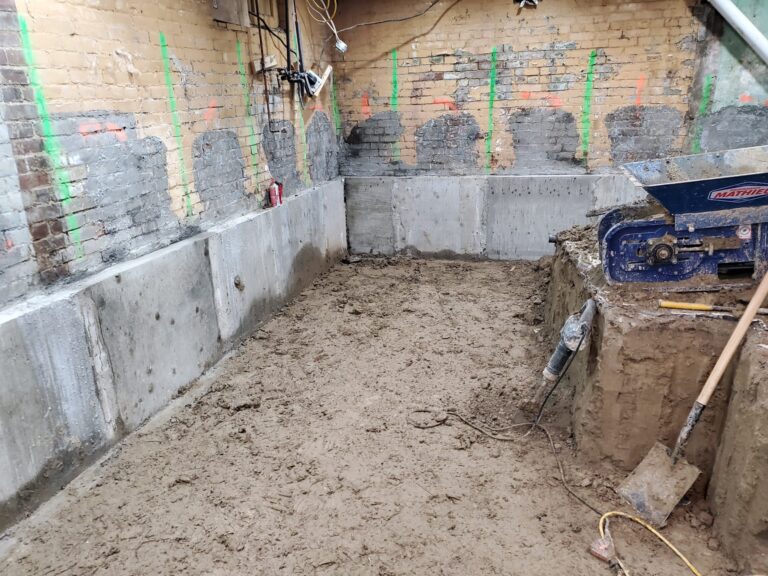The need for expanded space has one unique problem. Land is a finite resource. Basement underpinning can expand livable space without increasing a property’s footprint.
When Toronto homes were first built, basements were not living spaces. Owners would use them to store materials, food, or general empty space.
As the demand for space increased, residents began to wonder if they could convert basements into habitable dwellings. They could increase the liveable area of a home without expanding its footprint.
The idea of a finished, habitable basement was great for investors, too. With a basement apartment, an owner could convert a single family dwelling into two units. One unit would exist on the upper two floors with a completely separate unit downstairs. Finally, a way to convert dead space into a revenue-generating asset.
This has only one problem: most basements were not dug with the idea of (comfortable) occupancy in mind. Most of the basements in older homes had a ceiling height of 5 feet at best.

So, what’s the solution to a basement that is too low to stand tall in? The answer is Basement Underpinning.
On This Page
What Is Underpinning?
Basement underpinning is the act of lowering an existing foundation’s depth by pouring new footings BELOW the current ones. The result of an underpinning can be stable construction below the grade of a home.
To understand how underpinning works, its important to understand a home’s foundation.
A house’s footing is the lowest constructed part of the structure. The purpose of the footing is to distribute the weight of the entire structure onto the soil.

Footings are typically 16-24 inches wide and 6 to 16 inches thick. If the footing were to fail, the entire structure above would shift. This could cause significant structural concerns.
On top of the footing rests the foundation. The foundation’s purpose is to send the weight of the home down to the footings, below the frost line. Foundation’s must resist lateral pressure from the soil so that they do not cave in. Most foundations are actually basement walls.
Underpinning is the act of extending the footing further into the ground. The effect converts the existing footing into foundation, resting on the newly poured footing beneath it.
This is done by digging down to the footing, and then carefully digging and pouring below it. Basement underpinning can add an extra 2-3 feet of height to the basement.

Underpinning Alternative: Benching
Underpinning is not the only way to lower a basement. If you have enough room, a cheaper alternative exists. Benching is another way to add some height to your basement’s ceiling.
Unlike underpinning, the new footing does not go directly below the old one. Instead, benching is the process of pouring a new footing beside the old one.

In doing so, the weight shifts from the old footing to the new “benched” footing. This lowers the basement floor to the bottom of the bench.
Although benching is usually cheaper than underpinning, there is a major drawback. The technique creates a “bench” with a height equal to the old basement’s previous floor. Depending on how deep you’re going, the bench can be as wide as 1-2 feet.

While this design can take away from a basement’s useable square footage, homeowners have been creative with finding ways to blend the bench with the design of the house.
Legal Basement Apartments in Ontario
The Cost of Underpinning in Toronto
The cost of lowering a basement in Toronto varies. Residents must consider several factors. The original footing and foundation style, soil quality, and water characteristics of the neighbourhood are all factors that play a part in feasibility.
As of 2022, the cost of underpinning a basement in Toronto is around $50,000.
Benching is a more affordable option when looking to lower a basement. Leaving the original footing undisturbed eliminates a significant number of variables.
Is Underpinning Worth the Investment?
Houses with (proper) finished basements tend to sell for more than those without. The addition of useable space below the home can add significant value, especially if the unit can be converted into a second unit.
However, there are three reasons why underpinning might be an effective means to add value to your home:
1. Underpinning adds No Calculable Square Footage
Toronto Zoning requirements dictate that a home may have a total number of square feet. This figure, known as gross floor area (GFA), is calculated based on lot size.
Basements are not considered when calculating gross floor area. As a result, underpinning is an efficient way to add space without causing the property to become non-conforming.
2. Underpinning is Cost Effective
The cost to underpin an average basement in Toronto is $50,000. Benching can be significantly cheaper than this. In both instances, useable space is added to a property.
In comparison, ALTUS Group estimates the cost of an addition to be over $500 per finished square foot. This means that the same $50,000 would only yield about 100 square feet (or a 10 by 10 room).
3. Benching and Underpinning Can Fix Water Issues
When done correctly, the processes of benching and underpinning can give the owner the ability to fix water-related issues. Parging and damp proofing is installed in the new basement, along with vapour barrier. Underpinning can end water-related basement issues.

Conclusion
Underpinning a basement in Toronto is no easy feat. Expert advice should be sought prior to the commencement process. Engineers approvals are required in Toronto to comply with building code requirements.
Are you looking at properties with Underpinning? Contact Us for assistance on your next project.


